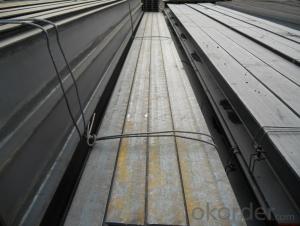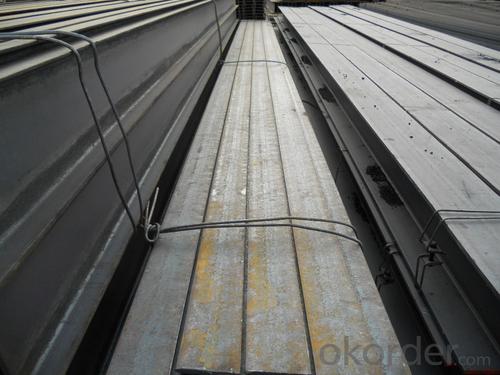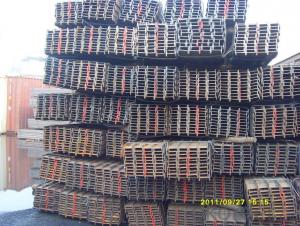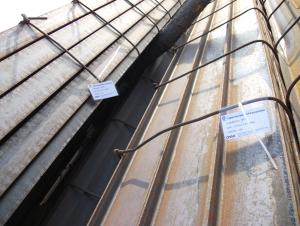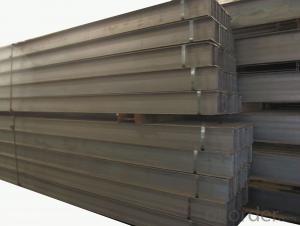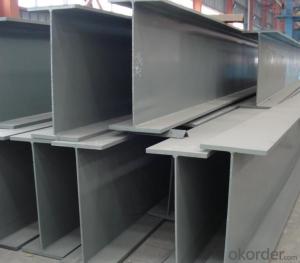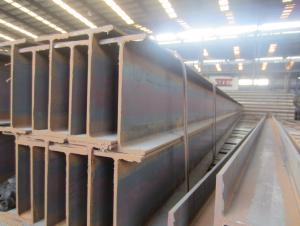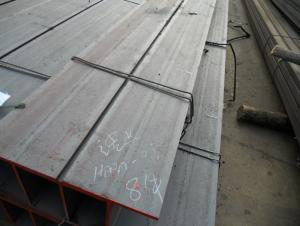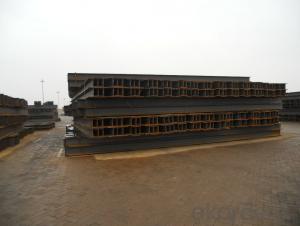Hot Rolled Low Carbon H Beam at Length 12m
- Loading Port:
- China main port
- Payment Terms:
- TT OR LC
- Min Order Qty:
- 100 m.t.
- Supply Capability:
- 10000 m.t./month
OKorder Service Pledge
OKorder Financial Service
You Might Also Like
Product Description:
OKorder is offering Hot Rolled Low Carbon H Beam at Length 12m at great prices with worldwide shipping. Our supplier is a world-class manufacturer of steel, with our products utilized the world over. OKorder annually supplies products to African, South American and Asian markets. We provide quotations within 24 hours of receiving an inquiry and guarantee competitive prices.
Product Applications:
Hot Rolled Low Carbon H Beam at Length 12m are ideal for structural applications and are widely used in the construction of buildings and bridges, and the manufacturing, petrochemical, and transportation industries.
Product Advantages:
OKorder's Hot Rolled Low Carbon H Beam at Length 12m are durable, strong, and wide variety of sizes.
Main Product Features:
· Premium quality
· Prompt delivery & seaworthy packing (30 days after receiving deposit)
· Can be recycled and reused
· Mill test certification
· Professional Service
· Competitive pricing
Product Specifications:
Manufacture: Hot rolled
Grade: Q195 – 235
Certificates: ISO, SGS, BV, CIQ
Length: 12m
Packaging: Export packing, nude packing, bundled
| size | h (MM) | b (MM) | t1 (MM) | t2 (MM) | theoretical kg/m | length |
| 100*100 | 100 | 100 | 6 | 8 | 16.9 | 12m |
| 125*125 | 125 | 125 | 6.5 | 9 | 23.6 | 12m |
| 150*75 | 150 | 75 | 5 | 7 | 14 | 12m |
| 150*150 | 150 | 150 | 7 | 10 | 31.1 | 12m |
| 148*100 | 148 | 100 | 6 | 9 | 20.7 | 12m |
| 198*99 | 198 | 99 | 4.5 | 7 | 17.8 | 12m |
| 200*100 | 200 | 100 | 5.5 | 8 | 20.9 | 12m |
| 248*124 | 248 | 124 | 5 | 8 | 25.1 | 12m |
| 250*125 | 250 | 125 | 6 | 9 | 29 | 12m |
| 300*150 | 300 | 150 | 6.5 | 9 | 36.7 | 12m |
| 298*149 | 298 | 149 | 5.5 | 8 | 32 | 12m |
| 200*200 | 200 | 200 | 8 | 12 | 49.9 | 12m |
| 294*200 | 294 | 200 | 8 | 12 | 55.8 | 12m |
| 346*174 | 346 | 174 | 6 | 9 | 41.2 | 12m |
| 350*175 | 350 | 175 | 7 | 11 | 49.4 | 12m |
| 244*175 | 244 | 175 | 7 | 11 | 43.6 | 12m |
| 175*175 | 175 | 175 | 5 | 11 | 40.4 | 12m |
| 294*200 | 294 | 200 | 8 | 12 | 55.8 | 12m |
| 346*174 | 346 | 174 | 6 | 9 | 41.2 | 12m |
| 350*175 | 350 | 175 | 7 | 11 | 49.4 | 12m |
| 400*200 | 400 | 200 | 8 | 13 | 65.4 | 12m |
| 396*199 | 396 | 199 | 7 | 11 | 56.1 | 12m |
| 450*200 | 450 | 200 | 9 | 14 | 74.9 | 12m |
| 446*199 | 446 | 199 | 8 | 12 | 65.1 | 12m |
| 340*250 | 340 | 250 | 9 | 14 | 78.1 | 12m |
| 500*200 | 500 | 200 | 10 | 16 | 88.1 | 12m |
| 300*150 | 300 | 150 | 6.5 | 9 | 36.7 | 12m |
FAQ:
Q1: Why buy Materials & Equipment from OKorder.com?
A1: All products offered byOKorder.com are carefully selected from China's most reliable manufacturing enterprises. Through its ISO certifications, OKorder.com adheres to the highest standards and a commitment to supply chain safety and customer satisfaction.
Q2: what is the difference between actual weight and theoretical weight?
A2: All the section steel has two weights: actual weight and theoretical weight. Actual weight is the weighing out when the product delivered from the mill. Theoretical weight is calculated by pieces. The invoice can be based on each of them as your request.
Q3: How many tons of steel products could be loaded in containers?
A3: Usually the steel products are delivered by bulk vessel because of the large quantity and the freight. However, there are no bulk vessel enter some seaports so that we have to deliver the cargo by containers. The 6m steel product can be loaded in 20FT container, but the quantity is changed according to the size, usually from 18tons to 25tons.
Images:
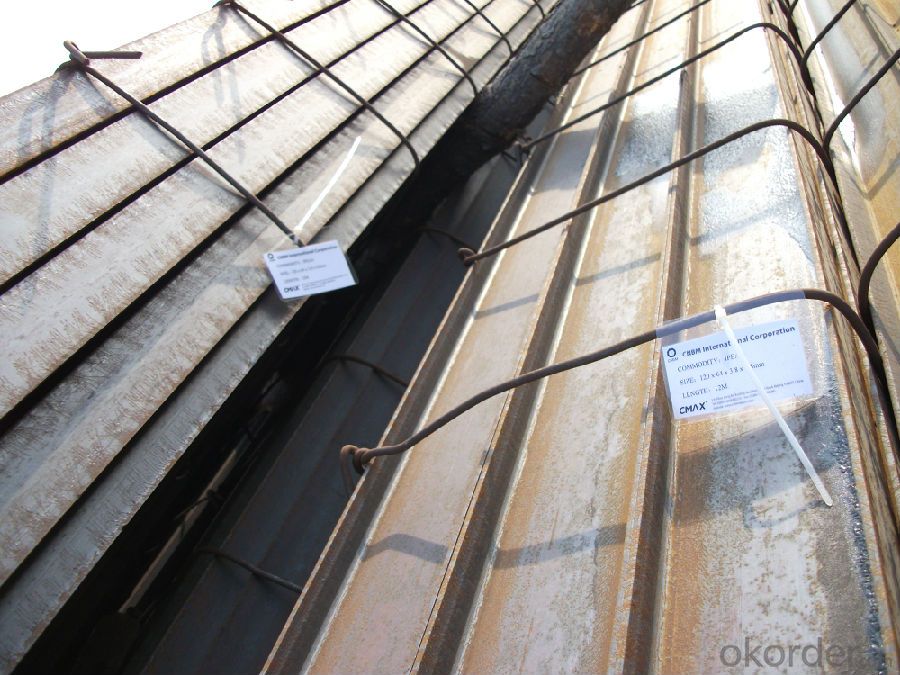

- Q: What are the factors to consider when selecting steel H-beams for a construction project?
- When selecting steel H-beams for a construction project, there are several important factors to consider. 1. Load-bearing capacity: The primary purpose of H-beams is to provide structural support and bear heavy loads. Therefore, it is crucial to determine the anticipated load requirements for the construction project. The load-bearing capacity of H-beams is typically specified by their height, thickness, and the type of steel used. 2. Size and dimensions: H-beams come in various sizes and dimensions, and it is essential to select the appropriate size that can adequately support the structure. The height, width, and thickness of the beam should be carefully chosen based on the design requirements and anticipated loads. 3. Steel grade: The selection of steel grade is crucial as it determines the strength and durability of the H-beams. Different steel grades have varying mechanical properties, such as yield strength and tensile strength. It is important to consult with a structural engineer or steel supplier to identify the suitable steel grade for the project. 4. Cost-effectiveness: While ensuring the structural integrity of the construction project is paramount, it is also crucial to consider the cost-effectiveness of the selected H-beams. Comparing prices from different suppliers and considering factors such as transportation costs and availability can help in making an informed decision. 5. Compatibility with other materials: H-beams are often used in conjunction with other construction materials, such as concrete or wood. It is important to ensure that the selected H-beam is compatible with these materials and can be easily integrated into the overall design and construction process. 6. Quality and certification: When selecting steel H-beams, it is essential to ensure that they meet the required quality standards and are certified by relevant authorities. This helps ensure that the beams have been manufactured using appropriate processes and adhere to industry standards. In conclusion, when selecting steel H-beams for a construction project, factors such as load-bearing capacity, size and dimensions, steel grade, cost-effectiveness, compatibility with other materials, and quality and certification should be carefully considered to ensure the structural integrity and success of the project.
- Q: How do steel H-beams perform in structures subjected to vibration?
- Due to their shape and material properties, steel H-beams excel in structures exposed to vibration. The H-shaped cross-section of these beams offers exceptional resistance against bending and torsional forces, making them the ideal option for withstanding vibration loads. The effectiveness of steel H-beams in dampening vibrations and reducing energy transmission throughout the structure is due to their structural rigidity and stiffness. This is particularly crucial in situations where vibrations can cause fatigue, excessive deflection, or even structural failure. Furthermore, steel is renowned for its high strength-to-weight ratio and outstanding durability, which further enhances the performance of H-beams in vibrating environments. This enables them to endure dynamic loads without significant deformation or compromising structural integrity, ensuring the long-term stability and safety of the structure. Moreover, engineers can customize the design and fabrication of steel H-beams to meet specific vibration requirements based on anticipated loads. By adjusting dimensions, material properties, and connection details, the beam's performance can be optimized to effectively mitigate vibrations and uphold the structural integrity of the system. Overall, steel H-beams are highly effective in structures subjected to vibration. Their unique shape, material properties, and ability to dampen vibrations make them a reliable and preferred choice for various applications, including bridges, industrial buildings, and other structures where dynamic loads are a concern.
- Q: How do Steel H-Beams compare in terms of lifespan and durability?
- The exceptional lifespan and durability of steel H-Beams are well-known. These structural members are specifically designed to withstand heavy loads and provide long-lasting support for various construction projects. Unlike wood or concrete, the lifespan of steel H-Beams can be significantly longer. The durability of steel H-Beams can be attributed to several key factors. Firstly, steel itself is inherently strong, with superior tensile strength and resistance to bending and twisting forces. This enables the H-Beams to endure extreme weather conditions, seismic activity, and other external factors that could potentially damage structures over time. Moreover, steel H-Beams are not susceptible to rot, decay, or insect infestations like wooden beams. They also do not degrade or weaken under moisture, a common issue with concrete structures. This makes steel H-Beams highly durable and reliable, ensuring their long-term performance and structural integrity. Additionally, steel H-Beams are resistant to fire, further enhancing their lifespan and durability. Steel has a high melting point and does not contribute fuel to a fire, making it a safer choice for structural elements. This characteristic is particularly important in high-rise buildings or structures where fire protection is crucial. Furthermore, steel H-Beams can be easily inspected for signs of wear or damage. Regular maintenance and inspections can help identify and address any issues promptly, ensuring the continued durability and longevity of these structural members. In conclusion, steel H-Beams possess remarkable lifespan and durability due to their high strength, resistance to environmental factors, and fire resistance. These qualities make them an excellent choice for a wide range of construction projects where longevity and structural integrity are of utmost importance.
- Q: How are steel H-beams specified in construction drawings?
- Steel H-beams are specified in construction drawings by providing detailed information about their dimensions, such as the height, width, and thickness of the flanges and web, as well as the overall length. The drawings also include information about the steel grade, tolerances, and any specific requirements for welding or connections. Additionally, the drawings may indicate the location and orientation of the H-beams within the structure, along with any necessary details or notations for installation.
- Q: What is the difference between wide flange and I-beam steel H-beams?
- Wide flange and I-beam steel H-beams differ primarily in their shape and dimensions. Wide flange beams, also known as W beams, have a wider flange and are more commonly used in structural applications. They have a wider profile, resembling the letter "H" when viewed from the side. On the other hand, I-beam steel H-beams have a narrower flange and are typically used in applications where weight-bearing capacity is crucial, such as in bridges and high-rise buildings. The shape of I-beam steel H-beams resembles the letter "I" when viewed from the side. Overall, the main difference lies in their dimensions and specific applications.
- Q: Can steel H-beams be used in the construction of government or municipal buildings?
- Absolutely, government or municipal buildings can certainly utilize steel H-beams in their construction. Due to their exceptional strength, durability, and versatility, steel H-beams are widely employed within the construction industry. They offer excellent structural support and possess the ability to endure heavy loads, rendering them appropriate for a range of building types, including government or municipal buildings. Government or municipal buildings often necessitate expansive open spaces, lengthy spans, and robust structural systems in order to accommodate various functions and activities. Steel H-beams provide the necessary strength and stability to fulfill these requirements. They can be employed as columns, beams, or trusses, thereby creating a resilient framework for the structure of the building. Moreover, steel H-beams boast remarkable flexibility in terms of design and can be easily fabricated to meet specific architectural and structural demands. This empowers architects and engineers to fashion distinctive and visually appealing government or municipal buildings while upholding structural integrity. Additionally, steel H-beams possess numerous advantages over alternative construction materials. They possess fire-resistant and non-combustible properties, and can withstand harsh weather conditions, making them ideal for government or municipal buildings that prioritize safety and durability. In conclusion, steel H-beams represent a practical and efficient choice for the construction of government or municipal buildings. Their strength, durability, design flexibility, and resilience against fire and extreme weather conditions all contribute to their reliability in creating safe and long-lasting structures.
- Q: Can steel H-beams be used for composite structures?
- Yes, steel H-beams can be used for composite structures. Composite structures typically refer to a combination of different materials, such as steel and concrete or steel and fiberglass, working together to form a stronger and more efficient structure. Steel H-beams are often used as a supporting element in composite structures due to their high strength-to-weight ratio and ability to withstand heavy loads. They can be combined with other materials, such as concrete or fiberglass, to create a composite structure that takes advantage of the unique properties of each material. Steel H-beams provide the necessary structural support while the composite materials contribute to additional strength, durability, and other desired characteristics. Overall, the use of steel H-beams in composite structures allows for the creation of versatile and efficient structures that can meet various engineering and architectural requirements.
- Q: Are steel H-beams suitable for use in the construction of airports or terminals?
- Yes, steel H-beams are suitable for use in the construction of airports or terminals. Steel H-beams are a commonly used structural element in construction due to their strength and durability. They are designed to withstand heavy loads and provide stability to structures. Airports and terminals require strong structural elements to support large spans, accommodate heavy equipment, and withstand dynamic loads from aircraft. Steel H-beams are capable of meeting these requirements, making them an ideal choice for such construction projects. Additionally, steel H-beams offer several advantages over other materials. They are fire-resistant, have a long lifespan, and require low maintenance. These properties make them a cost-effective option in the long run. Furthermore, steel H-beams can be easily fabricated and erected, allowing for efficient construction timelines. Their versatility allows for flexibility in design, enabling architects and engineers to create customized solutions for the specific needs of airports or terminals. In summary, steel H-beams are suitable for use in the construction of airports or terminals due to their strength, durability, fire resistance, and low maintenance requirements. They offer a cost-effective and efficient solution for creating stable and reliable structures that can withstand the demands of these facilities.
- Q: Can steel H-beams be used for shopping centers?
- Yes, steel H-beams can be used for shopping centers. Steel H-beams are commonly used in commercial construction, including shopping centers, due to their strength, durability, and ability to support heavy loads.
- Q: Can steel H-beams be used for parking structures?
- Parking structures can indeed utilize steel H-beams. Commonly referred to as I-beams, steel H-beams are widely used in construction due to their structural strength and load-bearing capabilities. Their design enables them to endure heavy loads and provide exceptional support, qualifying them for various applications, including parking structures. Steel H-beams offer multiple advantages for parking structures. For instance, they have the ability to span long distances without the need for intermediate support columns, thereby maximizing space utilization. Moreover, steel is a resilient and long-lasting material that can withstand harsh weather conditions and resist fire, corrosion, and pests. Hence, steel H-beams are an excellent choice for constructing parking structures that necessitate strength, stability, and durability.
Send your message to us
Hot Rolled Low Carbon H Beam at Length 12m
- Loading Port:
- China main port
- Payment Terms:
- TT OR LC
- Min Order Qty:
- 100 m.t.
- Supply Capability:
- 10000 m.t./month
OKorder Service Pledge
OKorder Financial Service
Similar products
Hot products
Hot Searches
Related keywords
